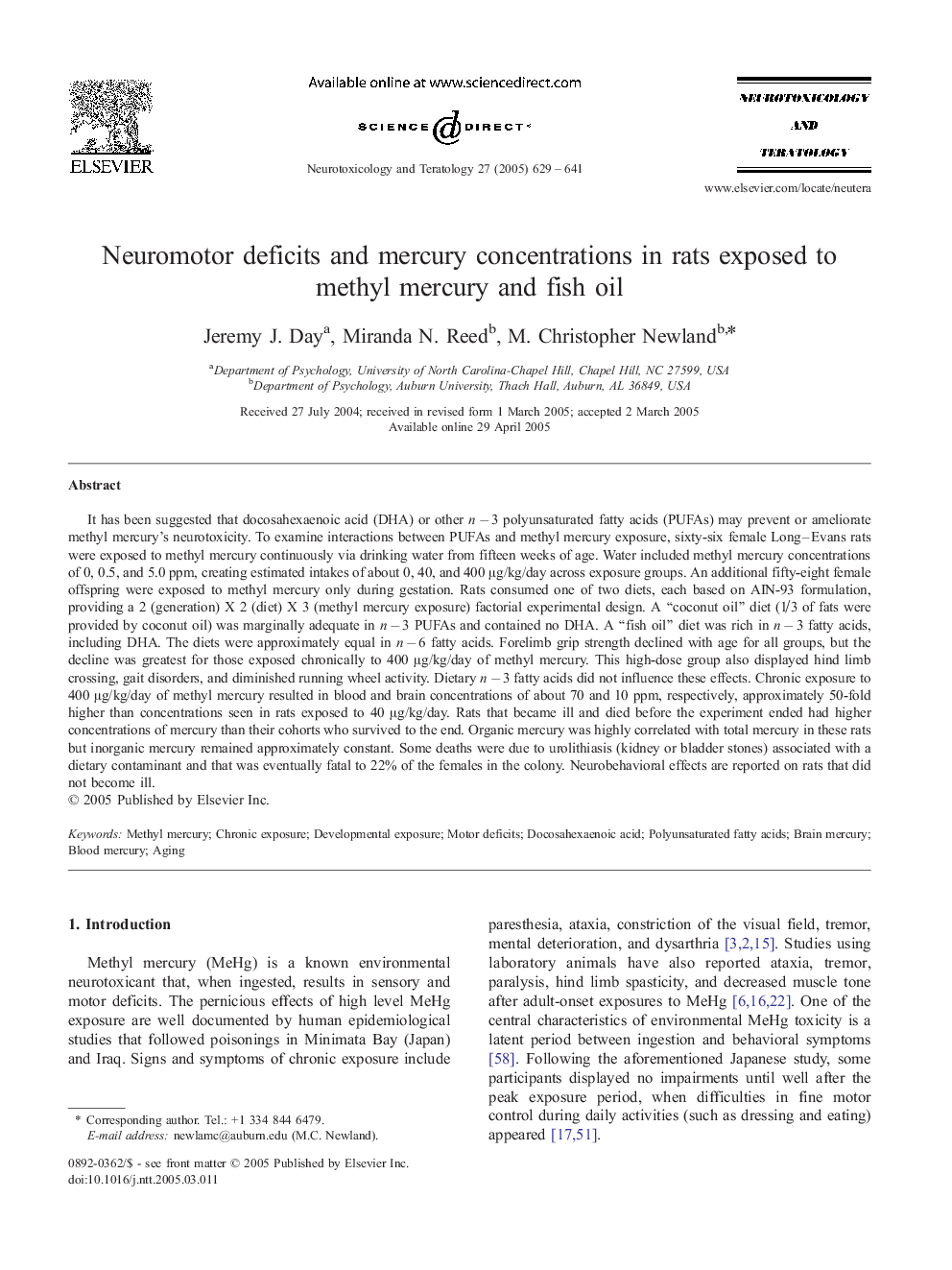| کد مقاله | کد نشریه | سال انتشار | مقاله انگلیسی | نسخه تمام متن |
|---|---|---|---|---|
| 9033250 | 1131868 | 2005 | 13 صفحه PDF | دانلود رایگان |
عنوان انگلیسی مقاله ISI
Neuromotor deficits and mercury concentrations in rats exposed to methyl mercury and fish oil
دانلود مقاله + سفارش ترجمه
دانلود مقاله ISI انگلیسی
رایگان برای ایرانیان
کلمات کلیدی
موضوعات مرتبط
علوم زیستی و بیوفناوری
علوم محیط زیست
بهداشت، سم شناسی و جهش زایی
پیش نمایش صفحه اول مقاله

چکیده انگلیسی
It has been suggested that docosahexaenoic acid (DHA) or other n â 3 polyunsaturated fatty acids (PUFAs) may prevent or ameliorate methyl mercury's neurotoxicity. To examine interactions between PUFAs and methyl mercury exposure, sixty-six female Long-Evans rats were exposed to methyl mercury continuously via drinking water from fifteen weeks of age. Water included methyl mercury concentrations of 0, 0.5, and 5.0 ppm, creating estimated intakes of about 0, 40, and 400 μg/kg/day across exposure groups. An additional fifty-eight female offspring were exposed to methyl mercury only during gestation. Rats consumed one of two diets, each based on AIN-93 formulation, providing a 2 (generation) X 2 (diet) X 3 (methyl mercury exposure) factorial experimental design. A “coconut oil” diet (1/3 of fats were provided by coconut oil) was marginally adequate in n â 3 PUFAs and contained no DHA. A “fish oil” diet was rich in n â 3 fatty acids, including DHA. The diets were approximately equal in n â 6 fatty acids. Forelimb grip strength declined with age for all groups, but the decline was greatest for those exposed chronically to 400 μg/kg/day of methyl mercury. This high-dose group also displayed hind limb crossing, gait disorders, and diminished running wheel activity. Dietary n â 3 fatty acids did not influence these effects. Chronic exposure to 400 μg/kg/day of methyl mercury resulted in blood and brain concentrations of about 70 and 10 ppm, respectively, approximately 50-fold higher than concentrations seen in rats exposed to 40 μg/kg/day. Rats that became ill and died before the experiment ended had higher concentrations of mercury than their cohorts who survived to the end. Organic mercury was highly correlated with total mercury in these rats but inorganic mercury remained approximately constant. Some deaths were due to urolithiasis (kidney or bladder stones) associated with a dietary contaminant and that was eventually fatal to 22% of the females in the colony. Neurobehavioral effects are reported on rats that did not become ill.
ناشر
Database: Elsevier - ScienceDirect (ساینس دایرکت)
Journal: Neurotoxicology and Teratology - Volume 27, Issue 4, JulyâAugust 2005, Pages 629-641
Journal: Neurotoxicology and Teratology - Volume 27, Issue 4, JulyâAugust 2005, Pages 629-641
نویسندگان
Jeremy J. Day, Miranda N. Reed, M. Christopher Newland,